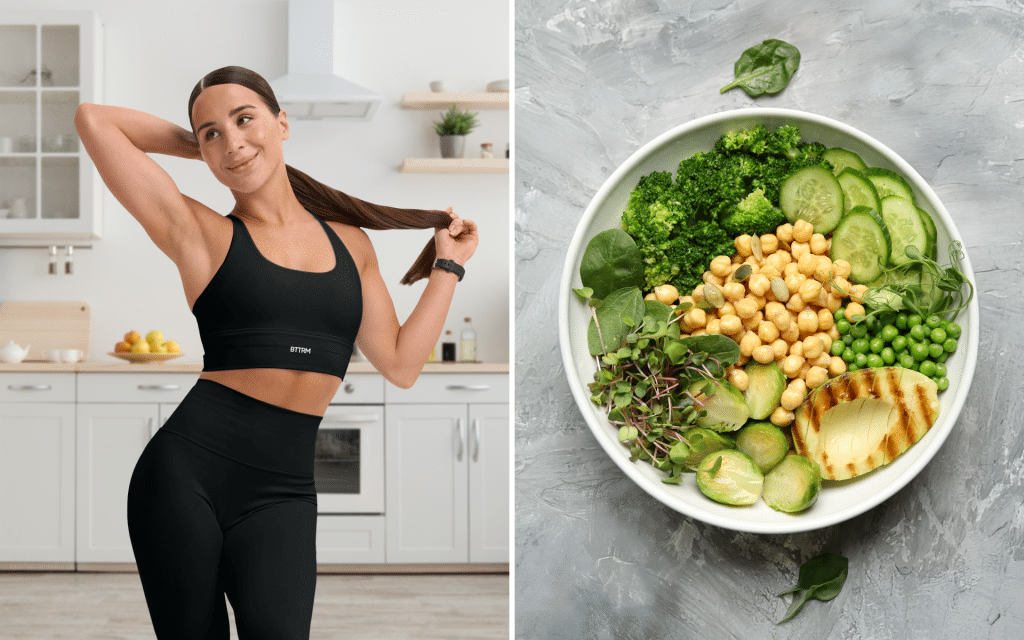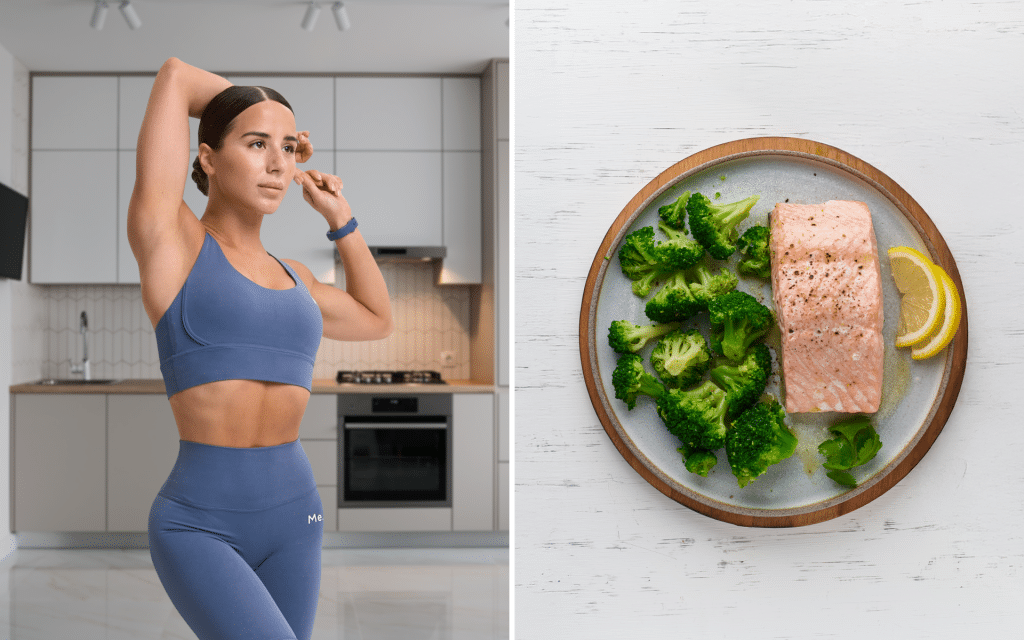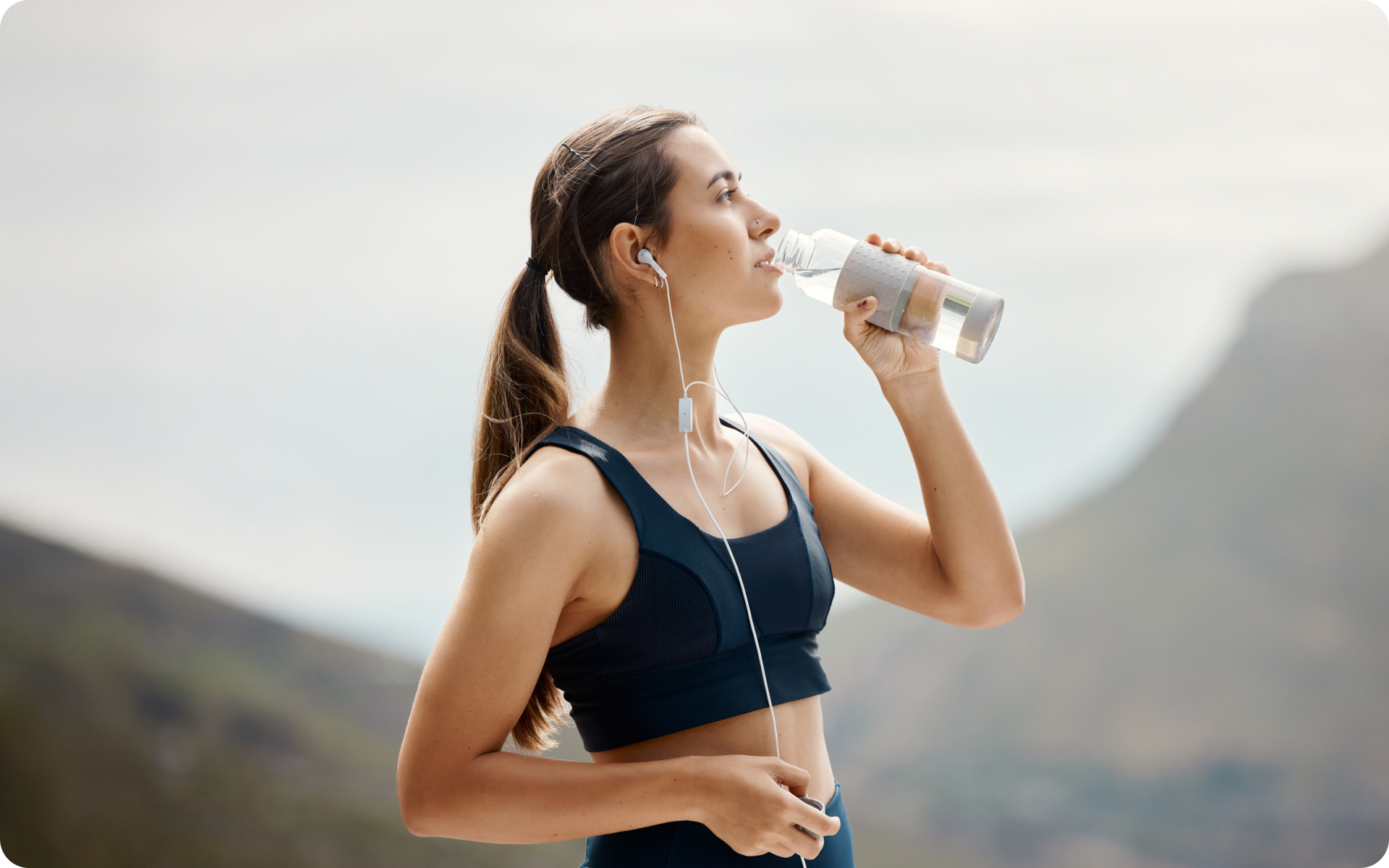Fasting while exercising to gain muscle seems counter-intuitive. On the one hand, you need a caloric surplus to build muscle (1), but on the other hand, intermittent fasting involves restricting your eating window and potentially reducing your calorie intake (2).
So is it possible to combine the two for optimal muscle gain? Yes, by choosing the right intermittent fasting schedule.
There’s not enough research to determine a single “best” intermittent fasting schedule for muscle gain, as it’s ultimately dependent on individual factors such as body composition, training regimen, and personal preferences. However, there are a few popular schedules that have shown promising results for building muscle while also incorporating the potential benefits of intermittent fasting.
Can I Build Muscle While Intermittent Fasting?
It’s possible to build muscle while intermittently fasting. While traditional bodybuilding wisdom may suggest eating regular meals to keep your body in a constant anabolic state (3), research has suggested that intermittent fasting can also support muscle growth (4).
Intermittent fasting is actually thought to increase levels of human growth hormone (HGH), which plays a key role in building muscle (5).
Building muscle while intermittent fasting requires careful planning and consideration of key factors such as protein intake and timing, workout schedule, and overall calorie balance.
The best way to gain muscle and lose fat is to follow these tips:
- Prioritize Protein Like Your Gains Depend on It
When it comes to muscle growth, protein is non-negotiable. Your muscles need amino acids (the building blocks of protein) to repair and grow stronger after every workout (6).
During intermittent fasting, you’re eating in a limited time window, which means getting enough protein can feel challenging. You should aim for high-quality sources such as chicken, fish, eggs, tofu, or other protein-rich plant foods such as pulses, nuts, and seeds.
If your window is tight, a quality protein shake can help bridge the gap, giving your muscles the fuel they need. The goal? Around 1.5 grams of protein per kilogram of your body weight daily (7).
- Resistance Training Is Your Best Friend
If you’re not already lifting weights or doing resistance exercises, now’s the time to start. Resistance training is essential for signaling your muscles to grow (8), even while fasting intermittently. A well-structured program that includes compound movements such as squats, deadlifts, bench presses, and pull-ups will give you the most bang for your buck.
Don’t worry if you’re not a gym veteran, it’s all about progression. Start small and focus on mastering proper form. And remember, consistency beats intensity when you’re starting out.
- Timing Matters (But It’s Not Everything)
One question you may have is, “When should I eat during fasting to maximize muscle growth?” Although you don’t need to obsess over the clock, strategic nutrient timing can help.
You should try to schedule a protein-rich meal soon after your workout to kick-start muscle protein synthesis (the process your body uses to repair muscle) (9). You may also want to eat a carbohydrate-rich meal or snack some time before your workout to make sure you have enough energy. For example, if you work out at 4 pm, eat a snack at around 3 pm and eat your last meal of the day after your workout session. Always fuel up with balanced meals and try to spread out your protein intake during your eating window, rather than cramming it all into one meal.
This doesn’t mean you need to squeeze out perfection—most of the magic comes from a good combo of protein, calories, and exercise. Small tweaks like this can give you an edge.
Whether you’re a workout beast or just a beginner making your first foray into the world of fitness and dieting – BetterMe has a lot to offer to both newbies and experts! Install the app and experience the versatility first-hand!
- Calories Are the Foundation for Growth
Here’s a simple truth about building muscle: you need enough calories. Intermittent fasting can sometimes make it difficult to eat as much as your body needs, particularly if you’re eating in a short window.
To build muscle, you should aim to eat in a slight calorie surplus (10). That means consuming just a bit more than your body burns each day.
Apps or online calculators can help you estimate this number. Focus on nutrient-dense foods such as lean proteins, healthy fats, and complex carbs to hit your calorie needs without feeling overly stuffed.
Pro tip: break your meals into two or three hearty sittings during your eating window so you’re not playing catch-up late in the day.
- Water and Rest Keep You in the Game
Hydration and recovery may not sound as thrilling as smashing your personal records in the gym, but they’re just as important if you want to see gains. When you’re fasting, you may accidentally skimp on water since you’re skipping meals – don’t do this!
Dehydration can reduce workout performance and hinder recovery (11), so you should sip water throughout the day, even during fasting hours. Adding a pinch of salt or an electrolyte tablet can help you stay hydrated.
And don’t underestimate sleep. Your body repairs itself while you rest, so you should aim to get 7-9 hours of quality sleep each night to allow proper muscle recovery(12). Consider it the secret weapon in your muscle-building arsenal.
Read more: Intermittent Fasting Based On Age: Here’s The Truth, As Per Science
What Is the Best Intermittent Fasting for Muscle Gain?
The lean gains method is particularly effective for those who are looking to build muscle while maintaining a lean physique. It involves fasting for 16 hours and eating during an 8-hour window.
With an 8-hour eating window, you can fit in two to three solid meals packed with protein, carbs, and fats essential for muscle recovery and growth. The 16/8 method allows you to consume enough calories within your feeding window (13), which is essential for building muscle.
This method also aligns well with gym schedules. For example, you could train during your eating window so you can fuel up before your workout and recover afterward with a nutrient-dense meal to refuel your body and support muscle protein synthesis.
So if gaining muscle is your main goal, the 16/8 method is your best bet because of the following:
- Muscle Preservation: By ensuring adequate protein intake and aligning meals with workout times, the lean gains method can support muscle maintenance and growth.
- Flexibility: The 8-hour eating window provides flexibility in meal planning, which makes it easier to meet nutritional needs without feeling overly restricted.
- Fat Loss: The fasting period can help reduce your overall calorie intake, promoting fat loss while preserving muscle mass, if that’s your goal (14).
- Sustainability: The lean gains method can be easily maintained as a long-term lifestyle, which is essential for sustainable results.
That being said, it’s important to find the fasting method that works best for you and your lifestyle. Whether it’s 16/8, alternate day fasting, or another variation, consistency and proper nutrition will be key factors in helping you achieve your muscle-building goals.
Will I Lose Muscle if I Fast for 16 Hours?
Fasting for 16 hours shouldn’t cause you to lose muscle as long as you’re consuming enough calories and protein during your eating window.
Studies on time-restricted feeding, such as the 16/8 method, indicate that it may help maintain muscle mass while promoting fat loss (15). This is largely because the eating window allows for adequate protein and calorie intake, which are essential for muscle preservation.
Engaging in regular resistance training while following a 16/8 fasting schedule can further support muscle maintenance. Exercise stimulates muscle growth and helps counteract any potential muscle loss during fasting periods (16)
However, it’s important to listen to your body and make adjustments if necessary. If you feel that you’re losing strength or muscle mass, you should consider increasing your calorie intake or adjusting your fasting schedule.
Remember that every person’s body is different and may respond differently to intermittent fasting. It’s important to find a balance that works for you and supports both your fitness goals and overall health.
How to Bulk on Intermittent Fasting
1. Set a Calorie Surplus
To bulk effectively, you need to be in a calorie surplus—consuming more calories than your body needs for maintenance (10). Start by calculating your total daily energy expenditure (TDEE) and aim to eat 250-500 calories above that.
As your eating window is shorter with IF, you’ll need to prioritize calorie-dense foods to meet your goals without feeling overly full. For example:
- Add healthy fats such as peanut butter, avocado, seeds, and olive oil to your meals.
- Use calorie-rich carbs such as rice, oats, and sweet potatoes.
- Incorporate lean proteins such as chicken, eggs, fish, and Greek yogurt.
2. Balance Your Macronutrients
Proper macronutrient distribution is essential (6):
- Protein (10–35% of your calories): Supports muscle repair and growth. Aim for around 1.5 grams of protein per kilogram of body weight.
(Example foods: chicken, fish, eggs, Greek yogurt, tofu, protein powder) - Carbs (45–65%): Provide energy for intense workouts and replenish glycogen stores.
(Example foods: rice, pasta, oats, potatoes, fruits, whole-grain bread) - Fats (20–35%): Help maintain hormonal balance and offer a concentrated source of calories.
(Example foods: nuts, seeds, avocado, olive oil, fatty fish)
3. Plan Your Eating Window
Choose an eating window that works best for your schedule, such as 12 pm-8 pm or 10 am-6 pm, and stick to it consistently. Use the following strategy within your window:
- Break Your Fast with Protein and Carbs
Example: Grilled chicken, quinoa, and vegetables.
Protein jumpstarts muscle recovery, while carbs provide energy to perform in the gym. - Follow Up with a High-Calorie Meal
Example: Salmon with brown rice, avocado, and steamed broccoli.
This helps you hit your calorie surplus while staying satiated. - Snack or Combine Meals
Example: Protein shake blended with almond butter and bananas.
This is useful if you’re struggling to eat all your calories in two big meals.
4. Nutrient Timing Around Workouts
Nutrient timing plays a huge role in bulking during IF:
- Pre-Workout Meal: Eat a small snack with carbs and a little protein 1-2 hours before your workout (within your eating window). Example: a banana with almond butter.
- Post-Workout Meal: This is your most important meal. Recover with a protein-heavy meal paired with complex carbs to maximize muscle recovery and growth.
If your workout falls outside of your eating window, focus on staying hydrated pre-workout and don’t push yourself harder than you can handle without the energy to support your performance. You can consider breaking your fast with branched-chain amino acids (BCAAs) during your workout to prevent muscle breakdown (17).
5. Hydration Matters
Intermittent fasting can sometimes lead to dehydration as you’re consuming fewer meals (and their moisture content) during the day. Make it a priority to drink plenty of water throughout the day and include electrolyte-rich options such as coconut water, broth, or sports drinks.
6. Workout Strategies for Bulking
To maximize muscle growth:
- Focus on Resistance Training: Aim for 4-5 days of strength training per week targeting major muscle groups. Use progressive overload – gradually increase the weight, reps, or sets over time (18).
- Add Compound Movements: Exercises such as squats, deadlifts, bench presses, and pull-ups recruit multiple muscle groups, which gives you the best return for your effort.
- Limit Excessive Cardio: While some light cardio is beneficial for muscle strength and endurance (19), don’t overdo it. You may opt for short, high-intensity interval sessions if desired.
Reasons why BetterMe is a safe bet: a wide range of calorie-blasting workouts, finger-licking recipes, 24/7 support, challenges that’ll keep you on your best game, and that just scratches the surface! Start using our app and watch the magic happen.
7. Top Foods for Bulking on IF
Here’s a list of nutrient-dense foods that should make up the bulk of your diet:
- Proteins: Chicken breast, lean beef, turkey, eggs, fish, tofu, pulses, whey or plant-based protein powder.
- Carbs: Sweet potatoes, brown rice, oats, fruits, whole-grain pasta, quinoa.
- Fats: Avocado, peanut butter, olive oil, nuts, seeds, fatty fish.
- Vegetables: Spinach, broccoli, bell peppers, asparagus, zucchini.
Example meals:
- Meal 1: Grilled chicken, jasmine rice, steamed green beans.
- Meal 2: Salmon with sweet potatoes, avocado, sautéed spinach.
- Snack: Protein shake blended with almond butter, oats, and frozen berries.
8. Overcoming Challenges
- Struggling to Eat Enough Calories: Include liquid meals such as smoothies or shakes for easier digestion. Add calorie boosters such as nut butters, honey, or coconut milk.
- Low Energy Levels During Fasted Workouts: Sip on black coffee for a pre-workout pick-me-up. Adjust the fasting window so your eating time starts before your workout.
- Hitting Protein Goals in a Shorter Window: Lean on protein-dense foods (such as chicken, fish, and eggs) and supplements like whey protein.
Does Intermittent Fasting Reduce Belly Fat?
There’s a lot of debate and conflicting information on whether intermittent fasting can specifically target belly fat. Some argue that it’s just another form of calorie restriction, which may not have any effect on where the body stores fat.
However, there are some studies that have suggested intermittent fasting can reduce visceral fat (belly fat), which is the type of fat that is stored around organs and associated with health issues such as heart disease and diabetes (20). One study found that participants who followed an alternate day fast for four weeks had reduced abdominal fat without losing too much muscle mass, but they also lost fat in general (21).
Furthermore, other benefits of intermittent fasting such as reducing inflammation, improving insulin sensitivity, and increasing human growth hormone levels (22) may be associated with reducing belly fat.
It’s important to note that any form of weight loss, including intermittent fasting, requires a caloric deficit (23). So while intermittent fasting may help reduce belly fat, it’s important to also focus on maintaining a healthy diet and exercise routine to see the best results.
Read more: The Catabolic Fasting Zone: What Is It, And Why Does It Matter?
Do You Lose Muscle or Fat First?
When you start to lose weight, your body typically loses a combination of both fat and muscle. However, the proportion of fat to muscle loss can vary based on several factors.
A diet that’s high in protein can help preserve muscle mass while losing fat. If you’re in a calorie deficit without adequate protein, you may lose more muscle (24).
Engaging in resistance training or strength exercises can help maintain or even build muscle while losing fat. Without exercise, particularly strength training, you’re more likely to lose muscle (25).
Individuals with higher body fat percentages may lose fat more readily, while those with lower body fat may experience more muscle loss if they’re not careful with diet and exercise.
The right approach to weight loss should focus on preserving as much muscle mass as possible while losing fat. This can be achieved through a combination of proper nutrition and regular resistance training.
Yes, the 16:8 intermittent fasting method can be effective for bodybuilding. It provides an 8-hour eating window, which allows you to consume enough calories and nutrients to support muscle growth and recovery. This schedule works well with gym routines as you can schedule your workouts and eating windows to maximize performance and support recovery. In addition, it may help promote fat loss while preserving muscle mass, which makes it a practical choice for bodybuilders aiming to stay lean (18). Kimchi can be a good option to break a fast as it’s low in calories and rich in probiotics, which support gut health (26). However, it’s important to pair it with a protein-rich and balanced meal to ensure you’re meeting your nutritional needs, especially after fasting. Yes, some bodybuilders practice intermittent fasting to maintain muscle while reducing fat. It allows them to align their eating windows with their training schedules, which ensures adequate protein and calorie intake for muscle growth. Methods such as the 16:8 approach are popular among bodybuilders as they may support muscle preservation and fat loss. Yes, you can lift weights while intermittent fasting. Resistance training is essential for muscle growth and can be effectively paired with fasting. To maximize results, you should consider breaking your fast with a protein-rich meal after working out to support muscle recovery and repair. Ensure you meet your calorie and protein needs during your eating window to maintain energy and build muscle.Frequently Asked Questions
Is 16:8 fasting good for bodybuilding?
Is kimchi good to break a fast?
Do bodybuilders do intermittent fasting?
Can I lift weights while intermittent fasting?
The Bottom Line
Intermittent fasting can be an effective tool for building muscle if it’s done correctly. Prioritizing protein intake and timing, engaging in resistance training, and paying attention to calorie balance, hydration, and rest are all crucial components of a successful muscle-building plan that incorporates intermittent fasting. It’s also important to find a fasting method that suits your schedule and preferences for long-term sustainability.
DISCLAIMER:
This article is intended for general informational purposes only and does not serve to address individual circumstances. It is not a substitute for professional advice or help and should not be relied on for making any kind of decision-making. Any action taken as a direct or indirect result of the information in this article is entirely at your own risk and is your sole responsibility.
BetterMe, its content staff, and its medical advisors accept no responsibility for inaccuracies, errors, misstatements, inconsistencies, or omissions and specifically disclaim any liability, loss or risk, personal, professional or otherwise, which may be incurred as a consequence, directly or indirectly, of the use and/or application of any content.
You should always seek the advice of your physician or other qualified health provider with any questions you may have regarding a medical condition or your specific situation. Never disregard professional medical advice or delay seeking it because of BetterMe content. If you suspect or think you may have a medical emergency, call your doctor.
SOURCES:
- Is an Energy Surplus Required to Maximize Skeletal Muscle Hypertrophy Associated With Resistance Training (2019, pmc.ncbi.nlm.nih.gov)
- Intermittent Fasting: Exploring Approaches, Benefits, and Implications for Health and Weight Management (2024, npjournal.org)
- Nutritional Recommendations for Physique Athletes (2023, ncbi.nlm.nih.gov)
- Intermittent fasting and continuous energy restriction result in similar changes in body composition and muscle strength when combined with a 12 week resistance training program | European Journal of Nutrition (2022, link.springer.com)
- Insulin resistance reduction, intermittent fasting, and human growth hormone: secondary analysis of a randomized trial (2024, nature.com)
- Dietary Protein and Muscle Mass: Translating Science to Application and Health Benefit (2019, ncbi.nlm.nih.gov)
- Recent Perspectives Regarding the Role of Dietary Protein for the Promotion of Muscle Hypertrophy with Resistance Exercise Training (2018, ncbi.nlm.nih.gov)
- Strength training: Get stronger, leaner, healthier (2023, mayoclinic.org)
- 5 nutrition tips to maximize your workouts (2023, mayoclinichealthsystem.org)
- Is a Caloric Surplus Necessary to Build Muscle? (n.d., medicinenet.com)
- Hydration to Maximize Performance and Recovery: Knowledge, Attitudes, and Behaviors Among Collegiate Track and Field Throwers (2021, ncbi.nlm.nih.gov)
- Sleep and muscle recovery: endocrinological and molecular basis for a new and promising hypothesis (2011, pubmed.ncbi.nlm.nih.gov)
- 16:8 intermittent fasting: Benefits, how-to, and tips (2023, medicalnewstoday.com)
- Intermittent fasting and weight loss: Systematic review (2020, ncbi.nlm.nih.gov)
- Effects of eight weeks of time-restricted feeding (16/8) on basal metabolism, maximal strength, body composition, inflammation, and cardiovascular risk factors in resistance-trained males (2016, biomedcentral.com)
- The Effects of Intermittent Fasting Combined with Resistance Training on Lean Body Mass: A Systematic Review of Human Studies (2020, ncbi.nlm.nih.gov)
- Branched Chain Amino Acids (2018, ncbi.nlm.nih.gov)
- Progressive Overload Explained: Grow Muscle & Strength Today (n.d., blog.nasm.org)
- The (Many) Benefits of a Cardio Workout (2023, health.clevelandclinic.org)
- Estimated visceral adiposity is associated with risk of cardiometabolic conditions in a population based study (2021, nature.com)
- Alternate Day Fasting Improves Physiological and Molecular Markers of Aging in Healthy, Non-obese Humans (2019, sciencedirect.com)
- Intermittent Fasting and Metabolic Health (2022, pmc.ncbi.nlm.nih.gov)
- Optimal Diet Strategies for Weight Loss and Weight Loss Maintenance (2020, ncbi.nlm.nih.gov)
- Preserving Healthy Muscle during Weight Loss (2017, ncbi.nlm.nih.gov)
- Weight Loss Strategies and the Risk of Skeletal Muscle Mass Loss (2021, ncbi.nlm.nih.gov)
- Effects of kimchi on human health: a scoping review of randomized controlled trials (2023, biomedcentral.com)










